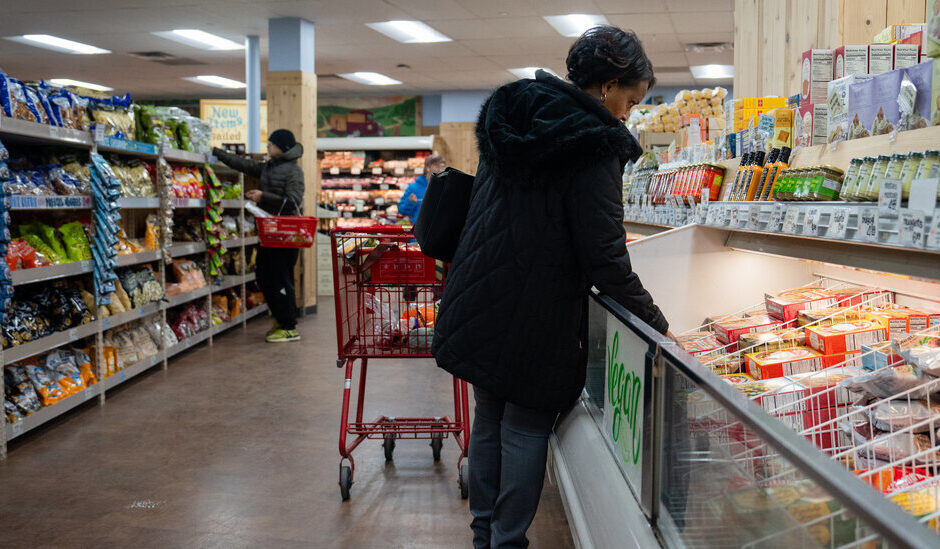Fresh off the worst inflation shock in decades, Americans are once again bracing for higher prices.
Expectations about future inflation have started to move up, according to metrics closely watched by officials at the Federal Reserve. So far, the data, including a consumer survey from the University of Michigan and market-based measures of investors’ expectations, does not suggest that price pressures are perceived to be on the verge of spiraling out of control.
But the recent jump has been significant enough to warrant attention, stoking yet more uncertainty about an economic outlook already clouded by President Trump’s ever-evolving approach to trade, immigration, taxation and other policy areas. On Tuesday, a survey from the Conference Board showed that consumer confidence fell sharply in February and inflation expectations rose as Americans fretted about the surging price of eggs and the potential impact of tariffs.
If those worries persist, it could be a political problem for Mr. Trump, whose promise to control prices was a central part of his message during last year’s campaign. It would also add to the challenge facing policymakers at the Fed, who are already concerned that progress against inflation is stalling out.
“This is the kind of thing that can unnerve a policymaker,” Jonathan Pingle, who used to work at the Fed and is now chief economist at UBS, said about the overarching trend in inflation expectations. “We don’t want inflation expectations moving up so much that it makes the Fed’s job harder to get inflation back to 2 percent.”
Most economists see keeping inflation expectations in check as crucial to controlling inflation itself. That’s because beliefs about where prices are headed can become a self-fulfilling prophecy: If workers expect the cost of living to rise, they will demand raises to compensate; if businesses expect the cost of materials and labor to rise, they will increase their own prices in anticipation. That can make it much harder for the Fed to bring inflation to heel.
That’s what happened in the 1960s and 1970s: Years of high inflation led consumers and businesses to expect prices to keep rising rapidly. Only by raising interest rates to a punishing level and causing a severe recession was the Fed able to bring inflation fully back under control.
When prices began rising rapidly in 2021 and 2022, many forecasters feared a repeat of that scenario. Instead, inflation expectations remained relatively docile — rising only modestly, and falling quickly once inflation began to ease — and the Fed was able to bring down inflation without causing a big increase in unemployment.
“The No. 1 reason why that scenario didn’t play out was that, even though inflation went up quite a bit, expected inflation by most measures only went up a little bit,” said Laurence Ball, an economist at Johns Hopkins University. “That’s the big difference between the 1970s and the 2020s.”
Now, though, there are hints that Americans are anticipating higher inflation in the years ahead. Persistent price pressures driven in part by a surge in the costs of eggs and energy-related expenses coupled with concerns about the impact of tariffs are among the factors to have pushed consumers’ expectations for inflation over the next 12 months to their highest level in more than a year, according to the long-running survey from the University of Michigan.
More concerning to economists, consumers’ expectations for inflation in the longer run — which tend to be more stable over time — experienced their biggest one-month jump since 2021 in February. The increase cut across age and income levels, suggesting inflation fears are widespread.
Expectations in the Michigan survey have risen before, only to fall back in subsequent months. And the recent results have shown a huge partisan split — inflation expectations have risen sharply among Democrats since the election, but have fallen among Republicans — leading some economists to discount the results.
Inflation expectations have also risen among political independents, however — a significant development because their assessment of the economy is typically more stable, said Joanne Hsu, who leads the Michigan survey.
But economists said that the longer inflation remained elevated, the greater the chances that consumers and businesses would start to readjust their expectations. What central banks fear most is if those expectations become “unanchored,” or move enough to suggest little confidence that over time inflation will return to the 2 percent target. That risk appears more prominent now than it did a few months ago. Progress on inflation has stalled in recent months and President Trump has pursued policies that many economists believe are likely to push prices higher, such as imposing tariffs and restricting immigration.
“The data does show that inflation expectations appear to be well anchored, but if I were at the Fed, I wouldn’t assume that or take that for granted,” said Richard Clarida, a former Fed vice chair who is now at Pimco, an investment firm.
Officials at the central bank have so far downplayed concerns about inflation expectations. Austan Goolsbee, president of the Federal Reserve Bank of Chicago, said the latest survey from the University of Michigan “wasn’t a great number,” but reflected just one month’s worth of data so far.
“You need at least two or three months for that to count,” Mr. Goolsbee, who casts votes on policy decisions this year, said on Sunday.
Alberto Musalem, president of the St. Louis Fed and a voting member, was also emphatic that inflation expectations were under control while talking to reporters last week. Mr. Musalem described the Michigan data as “one metric amongst a variety of metrics that has shown a little uptick.”
Despite this confidence, the Fed has put additional interest rate cuts on hold for the time being. Officials not only want more evidence that inflation is in retreat but have also said a solid economy affords them time to wait and see how Mr. Trump’s plan will impact the trajectory for consumer prices, the labor market and growth more broadly.
Minutes from the most recent policy meeting in January showed that policymakers expected some impact on consumer prices from Mr. Trump’s policies. But how the central bank should respond remains a big point of debate.
Some, like Fed governor Christopher J. Waller, have argued that the central bank can “look through” the economic impact of policies like tariffs. But that stance hinges on a number of factors, most crucially that such levies lead to only a one-off increase in prices and that expectations across businesses and households remain in check.
But according to Charles Evans, who retired as president of the Chicago Fed in 2023, that could be a risky strategy, especially in light of the inflation surge that followed the Covid-era economic shock.
“That’s the same transitory story the Fed and everybody was saying in 2021,” he said. “You would think that policymakers would be a little more reluctant to lean on that.”
Already, Mr. Evans said that seeing inflation expectations move up somewhat made him “a little nervous,” especially in light of his concerns that businesses might be more inclined than in the past to pass along higher prices to their customers. For those reasons, he expects the Fed to stay “cautious” about further interest rate cuts this year.
John Roberts, who most recently served as a top staff member in the division of research and statistics at the Fed before joining Evercore ISI, added that the central bank might be inclined to forgo cuts entirely this year if inflation expectations did not improve from current levels. At this point, he already sees “a little bit of unanchoring here.”
After the release of the latest University of Michigan data on Friday, economists at LHMeyer, a research firm, pushed back their timing for the next Fed cut from June to September.
There is also another risk: If Mr. Trump moves to erode the Fed’s independence, or threatens to do so, that could undermine confidence in the central bank’s ability to bring inflation under control, leading inflation expectations to rise.
Last week, Mr. Trump sought to expand his reach over the Fed as part of a broader effort to wrest greater control of congressionally designated independent agencies. The executive order targeted the central bank’s supervision and regulation of Wall Street and carved out its decisions on monetary policy. But the expansive nature of the order stoked concerns about how much further Mr. Trump’s encroachment on the Fed’s independence could eventually go.
“That’s the most dangerous scenario,” Mr. Ball said, adding that even the threat of political interference could make the Fed’s job more difficult. “The Fed’s ability to control expectations could be impeded not only by the Trump administration taking over, but also by the fear that might happen.”
#Consumer #Confidence #Drops #Americans #Brace #Inflation


